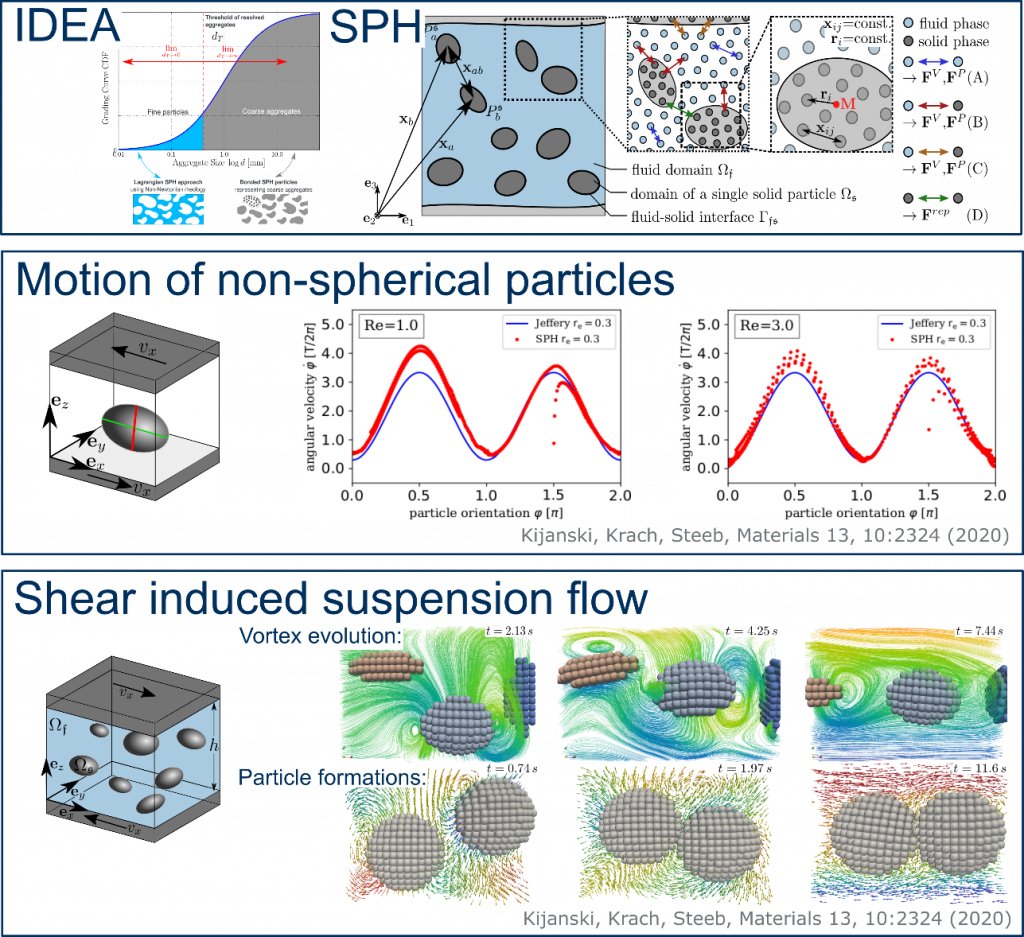17. Direct numerical simulation of dynamic aggregate migration in fresh concrete using multi-scale Smoothed-Particle Hydrodynamics
Principal investigator(s) – PI
- Prof. Dr.-Ing. Holger Steeb
Universität Stuttgart, Institut für Mechanik (Bauwesen)
Researcher(s) in-charge – RI
- Dipl.-Ing. Milos Simeunovic
Universität Stuttgart, Institut für Mechanik (Bauwesen)
Associated researcher – AR
- M.Sc. David Krach
Universität Stuttgart, Institut für Mechanik (Bauwesen) - M.Sc. Nadine Kijanski
Universität Stuttgart, Institut für Mechanik (Bauwesen)
Subject Areas
Concrete Rheology, Direct Numerical Simulations, Suspension Flow
Term
2018-2021
Project identifier
Deutsche Forschungsgemeinschaft (DFG) – STE 969/14-1
Projekt number 387065607
Project Description
The scientific objectives of the research project aim towards improving our understanding of graded fresh concrete flow in confined geometries using microstructure-resolved SPH simulations. In this regard, special attention will be devoted to shear-induced particle migration and lubrication layer formation processes motivated by their technological significance for concrete pumping. As these processes take place at length scales which are significantly smaller than the engineering length scale, resolved surface-coupled Direct Numerical Simulations (DNS) are considered appropriate approaches. In order to address the significant computational requirements of DNS, High-Performance Computing (HPC) approaches are used (massively parallel distributed memory computing) [5]. Our simulation approach explicitly takes into account the multi-scale nature of fresh concrete in that the rheology of the carrier fluid as well as the numerically resolved aggregate content is adaptively modified to adequately represent the dominating mechanisms at a suitable length and time scale [1]. Given our interest in particle migration processes, characteristic time scales we represent in our simulations are in the order of particle self-diffusion times. In other words, simulated time scales must be sufficient to study shear-induced dynamic aggregate segregation processes in graded concrete suspensions. This implies that our simulations are strongly separated from time-scales associated with the chemical reactivity of hydrating cement suspensions. As a result, this project focuses on the evolution of fresh concrete microstructure during flow, i.e. resulting in segregation effects such as heterogeneous particle size and concentration distributions, due to hydrodynamic and tribological effects [4]. Our scientific work program is tailored in such a way that our simulation results can ultimately provide a reliable data and knowledge basis to develop coarse-grained macroscopic models of fresh concrete flow during pumping. This data basis covers a feature space composed of mix design and boundary conditions. In that respect, the anticipated output of the present project is considered a valuable input to module 3 of the SPP 2005. A computationally optimized simulation framework for SPH simulations is available. This simulation framework is based on HOOMD-blue (Highly Optimized Object-oriented Many-particle Dynamics) and has previously proven good parallel performance on computer clusters we have access to [5]. Core algorithms related to the simulation of arbitrary-shaped rigid particles suspended in continuous carrier liquids (e.g. data structures, time integration routines) have been implemented. Within the duration of the project, comparatively little time thus is devoted to software implementation.

Idea, numerical method and results of the project DNS of dynamic aggregate migration in fresh concrete using SPH
Publications
M. Simeunović, H. Steeb
in: Special Issue: 90th Annual Meeting of the International Association of Applied Mathematics and Mechanics (GAMM) (2019)
Materials 13 (10) (2020)
Frontiers in Materials 144 (2022)
